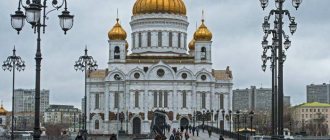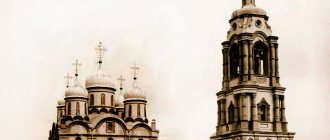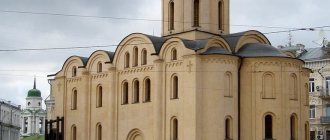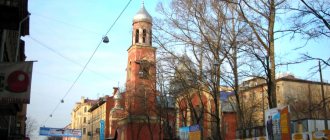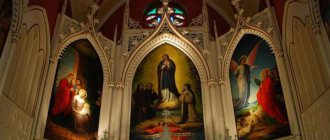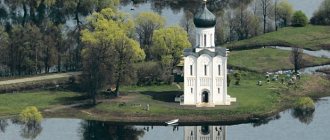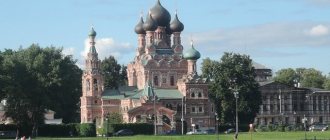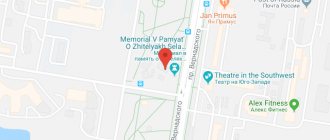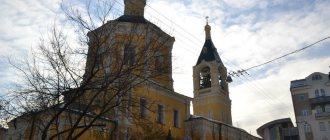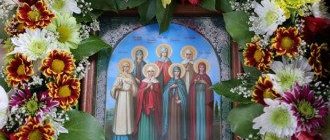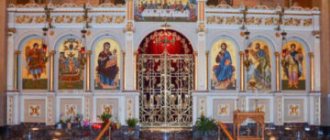In the south-eastern part of Moscow, in the Maryino district, there is a temple in memory of the Holy Myrrh-Bearing Women, which was founded in 2015.
Its construction was carried out within the framework of the “200 Temples” program. On its first floor there is a Sunday school. There is a social center at the temple, as well as a center for family support and motherhood.
The structure of the Church of the Holy Myrrh-Bearing Women in Maryino
The church was built mainly from wood, made in a style that is very characteristic of ancient Russian architecture.
Decoration of the temple from the inside
Construction of the temple began in 2013.
The first meeting of citizens regarding the construction of a temple on the territory of the Dusseldorf park was held on February 6, 2012 at Lyceum No. 1547. Residents of the Maryino district unanimously approved the construction of the temple.
Church of the Holy Myrrh-Bearing Women under construction
The construction of the temple took place step by step:
- On May 19, 2013, a prayer service was held at the Worship Cross on the site of the future cathedral;
- On March 29, 2014, the ceremony for the founding of the church was performed;
- September 6, consecration of the domes of the Church of the Holy Myrrh-Bearing Women;
- January 4, 2015 - illumination of the Church of the Holy Myrrh-Bearing Women in Maryino.
Priest Mikhail Sergeev was elected rector of the church under construction
The Holy Myrrh-Bearing Women - those who were the first to come to the tomb of Jesus
The temple is named after the holy Myrrh-Bearing Women. These are the women who were the first to come to the tomb of Jesus Christ on Sunday to anoint the body of the deceased with myrrh.
Seven Women, faithful to the Savior to the end. It was they who asked Pontius Pilate to allow him to take the body of Jesus for burial.
Seven myrrh-bearing women. Icon of the early 19th century
It is definitely worth mentioning the names of each of them:
- Mary Magdalene;
- Solomiya;
- John;
- Marfa;
- Maria Kleopova;
- Susanna;
- Maria.
The Gospel of John especially emphasizes that Mary Magdalene came to the tomb first.
In. 20:1-18
“One day from the Sabbath, Mary Magdalene came in the morning, while darkness was still present...”
Mary Magdalene - one of the seven Myrrh-Bearing Women
Church of the Myrrh-Bearing Women in Veliky Novgorod as a museum
The exhibition, called Hands - Work, Soul - Holiday, was organized by the staff of the Vitoslavlitsy Museum of Wooden Architecture. The fairly close location, 3.5 kilometers, is complemented by one more circumstance. In ancient times, the Church of the Myrrh-Bearing Women in Veliky Novgorod was religiously subordinate to the St. George's Monastery. A museum on the site of a degenerate village and one of the oldest Russian monasteries are immediate neighbors. The exhibition has an ethnographic focus, useful to the current owners of the building.
The exhibition presents traditional peasant occupations, crafts of local artisans, trading activities and family life. Most of the exhibits are preserved items from the second half of the 19th century or the beginning of the next. It is not always easy for our contemporaries to identify the purpose of exhibits without the help of explanatory texts. Of no less interest are the architectural features of the temple interior of the early 16th century, cosmetically updated by restorers.
Interiors and exhibits
Cross vaults, arched passages, window openings and niches, curious in themselves, are complemented by interesting exhibits. The Church of the Myrrh-Bearing Women in Veliky Novgorod with a cart at the turn of the gallery reminds of the profession of a cart master. The now vanishing craftsmen must have had a rare set of skills, from woodworking to metal forging. Shaft carts were the main transport from capitals to provincial villages; there was no alternative. The wheels and shafts wore out quickly due to bad roads, and the craftsmen were not idle.
People invented dishes in time immemorial, first adapting available objects, then mastering pottery. An unknown inventor figured out to make a rotating circle to turn a lump of clay into a smooth product. It was from the potter's wheel that wheels emerged, one of the most important devices to this day. Potters were not limited to replicating the simplest forms; creating new ones was the oldest form of creativity. Aesthetic needs gave rise to painting of vessels and other products, the first painting.
From potters to blacksmiths and other artisans
The metal in its original form was processed by cold forging and worked on a wooden block from a thick trunk. The hot method required a massive metal anvil, a forge for heating it red-hot, and bellows for fanning the coals. The Church of the Myrrh-Bearing Women in Veliky Novgorod presents blacksmith products for various purposes, nearby are fishing nets of varying degrees of readiness. Weaving nets was an independent craft, fishing was one of the ways of obtaining food. Several occupations provided peasant and craft farms with woven products.
Omitting the stage of caring for flax crops, we will describe its path to the canvas. After air-drying the plucked shoots, they were threshed on a threshing floor to obtain seeds for the following year. Then they dried it in an oven, crushed it and frayed it into soft fibers using special tools. Spinning threads was one of the main operations, the spindle and spinning wheel were the main tools. The threads were dyed in vats using dyes from plant materials, achieving bright and long-lasting colors.
Hand weaving is the main women's craft
Cattle breeding and agriculture provided the local population with food, and they also provided ungulate wool and plant fibers. Fibers were turned into threads of yarn on manual and mechanical spinning wheels; multi-spindle spinning wheels are considered the best. They even call this device one of the inventions of the brilliant da Vinci, but the validity has not been checked. One of the fragments of the exhibition, located in the Church of the Myrrh-Bearing Women in Veliky Novgorod, is entirely dedicated to the crafts of spinning and weaving.
Several examples of hand spinning wheels with the original fiber (tows) are presented, on the blade of which the woman sat. Several other designs comment on the museum's explanations on the plaques. Here you can also get acquainted with the basics of weaving using the example of a manual vertical loom, essentially a modification of an embroidery hoop. Warp threads were placed vertically, which were fastened with weft threads, threaded through devices - shuttles by the hands of weavers. The edge of a horizontal machine, more convenient and productive, is visible.
Wood is the basis of the ancient economy
Without belittling the role of metals, wood should still be recognized as the basis of the ancient Russian way of life. Dwellings and temples, dishes, furniture, tools and fixtures were made either entirely or partially from wood. In addition to the wood itself, the bark and young shoots of some trees were used; they were used for weaving. Making baskets and boxes from wicker and birch bark containers, weaving bast shoes, carving spoons and troughs occupied entire families, sometimes entire villages.
The variety of wooden products from the Church of the Myrrh-Bearing Women in Veliky Novgorod is so great that it is difficult to represent them by name. It is not difficult to identify their purpose; many have modern analogues or have remained unchanged. The preparation of wood for transformation into finished products, on the contrary, has undergone serious, even radical changes. Manual removal of tree bark is a thing of the past; only for individual crafts are peeling devices of the simplest device used.
Cultural and educational life of the temple
Within the walls of the temple cultural life is very developed. Many events and celebrations are held with the participation of parishioners. Much attention is paid to the cultural and educational development of youth. Film screenings are held for everyone.
The rector of the temple, Mikhail Sergeev, talks with young people as part of one of the events
The following educational associations operate in the temple:
- Gospel meetings;
- Youth Club;
- Sunday School.
One of the meetings of the youth club that operates in the temple.
Visiting the temple is possible on any day of the week. Church doors are open to everyone on any day of the week from 8-30 to 20-00. Everyone can confess at the evening service. At the morning meeting only children, the sick and the elderly.
Rector Mikhail Sergeev conducts a service in the church
Temple of the Holy Myrrh-Bearing Women
The Church of the Holy Myrrh-Bearing Women was built by the Kopiski family in the village of Krutovo, Petushinsky district, Vladimir region, from 2000 to 2003. The temple is made in the traditional northern style, widespread in Arkhangelsk, the homeland of the ancestors of Nina Valerievna Kuzmicheva-Kopiska.
The laying of the foundation stone for the church in honor of the Holy Myrrh-Bearing Women was performed by Archbishop of Vladimir and Suzdal Evlogii on October 6, 2000. On May 10, 2003, on the eve of the patronal feast, Archbishop Eulogius performed the Rite of Consecration of the temple.
For the newly consecrated church, the Bishop blessed the ancient icon of St. Theodosius of Chernigov. Mother Tabitha, abbess of the Murom Holy Trinity Convent, brought icons painted in the monastery workshop as a gift to the temple: the image of the Holy Trinity and Sts. the noble princes and miracle workers of Murom Peter and Fevronia with a particle of their holy relics.
The Church of the Holy Myrrh-Bearing Women was built in the traditions of ancient Russian wooden architecture and is a classic example of a tent-roofed church of the “octagon on a quadrangle with a refectory” type.
The tent above the main volume of the temple, crowned with a bulbous dome, is the main vertical line of the architectural design. The refectory part is quite short and is closely adjacent to the main quadrangle. From the west, the longitudinal composition is completed by a hipped bell tower and a porch leading to the main entrance to the church. On the northern and western sides, an open gallery adjoins the temple, which is visually perceived as a decorative design of a church building.
The Church of the Holy Myrrh-Bearing Women is located in the Klyazma floodplain on an embankment hill and from the outside looks like a majestic and monumental structure. A completely different impression arises inside the church. The internal volume turns out to be small, intimate and, at the same time, sufficient for a small number of rural parishioners.
The altar space is separated from the main volume by a high three-tier iconostasis, traditional for Rus'. The place for singers is located in the choir (upper tier), where a staircase leads from the vestibule. During the spring flood of the Klyazma, the temple ends up on an island, but parishioners easily get to it via a covered wooden bridge. Divine services in the temple are held on weekends.
For additional information about church services and the work of the Church of the Holy Myrrh-Bearing Women, please call +7 (495) 414-20-23.
The Church of the Holy Myrrh-Bearing Women in the city of Vladimir stood on modern Karl Marx Street.
Church in honor of the Holy Myrrh-Bearing Women. Photo. Con. 70s XIX century (GIM)
Church of St.
The Myrrh-Bearing Women was first mentioned in the inventory of the city of Vladimir for 1625. The church was cold, wooden, single-domed and, judging by its image on the “Drawing” of 1715, of the kletsky type (kletsky-type churches are based on one or more rectangular log frames - cages. Such forms for temples were borrowed from civil engineering). It stood behind the ramparts of the Vetchany City and was dedicated to the myrrh-bearing women - women who, according to church tradition, came on the third day to anoint the body of the buried Jesus Christ with fragrant myrrh. It can be assumed that the builder of the temple was a woman named after one of the myrrh-bearing women - Mary. 1628 - written mention in the patriarchal books: “the Church of the Holy Myrrh-Bearing Women in the suburb outside the city... tribute 12 altyn 4 dengi, vicars’ hryvnia.” In 164 (1656) the tribute from this church was increased: “32 altyns and two money were due.” In 1710-1715 the priest here was a certain Yakov Ivanov. In the inventory of 1628, next to the Church of the Myrrh-Bearers, the warm Church of St.
Leonty, Bishop of Rostov , with a chapel in the name of St. Guria and Barsanuphius, Kazan miracle workers. In 1732, the priest of the Myronositsk Church, Alexander Yakovlev, reported to the state synodal order that this church “became dilapidated and the roof was rotten and wood was made for this church”; therefore, he asked for permission to dismantle it with the chapel and re-build a warm church in the name of “Hodegetria the Most Holy.” Mother of God." According to the certificate in the order, it turned out that “according to the salary books of 732, there were 49 parish households in the Mironositsky parish, in the scribe books there were 133 and 134 (1625 and 1626). it is written: “reap 30 kopecks and reap 20 kopecks.” Meanwhile, sacred. Alexander Yakovlev stated that he would like to consecrate the new church “not in the name of the Hodegetria of the Most Holy Theotokos, but in honor of the Entry into the Temple of the Most Holy Theotokos.” On January 31, 1732, the requested permission was given and in the same year the warm church was built. As can be seen on the “Drawing” of 1715 and on the pre-regular plan of the city, from the Kremlin from the Ivanovsky Bridge along the slope of a natural plateau the road descended directly to the Myronositskaya Church. Below were the monastic settlements of two monasteries - Rozhdestvensky and Bogoroditsky. Monastery ministers and townspeople lived in the settlements; there, apparently, were small wooden churches with cemeteries. It is known that one of the churches was dedicated to St. Onuphrius the Great (built in 1720-21). She stood below the Bogoroditsky Monastery directly opposite the Virgin Mary Church. Her parish included about 20 households. The foundation of the church in the form of a square, laid out of white and wild stone, was visible back in 1850 and was presumably located on the site of house No. 14 on modern Zheleznodorozhnaya Street. The existence of a second church in the settlement near the Nativity Monastery can only be speculated. In 1850, workers while laying a descent to Klyazma discovered several ancient graves and remains of bones and skulls. According to local historian V.I., who observed the work. Dobrokhotov, in this place there was a Podmonastyrskaya settlement, where there was a church with a cemetery. Between these two churches in the 17th century. there was a wooden church of the Myrrh-Bearing Women. In May 1729, Corporal Fyodor Maksimov Koptev reported to the Vladimir Provincial Chancellery, “In front of the Church of the Myrrh-Bearing Women, in two places this shaft is dug up from the rain. The vegetable garden of the Volodymyr townsman Maxim Toporkov is 28 fathoms long along the shaft, 2 fathoms across and larger. Opposite the Bogoroditsky Monastery is the garden of the Volodymyer townsman Login Zagryazhsky, the length of the shaft is 15 fathoms, across the monastery by 2 and more...” In 1732, a new antimins was needed for the cold Myrrh Church, because in December 1731, “thieves’ people stole many church things and including the consecrated antimension from the throne,” and therefore the divine service was not performed in the church. This cold church existed until 1756. In 1756, in the month of April, a newly appointed priest from the Vladimir Assumption Convent in place of the priest Alexander Yakovlev who died in 1755 (this priest was buried near the Miron church) Andrei Vasiliev with the church warden Yakov Borovetsky asked for restructuring dilapidated Myronositsa Church. The Vladimir Spiritual Consistory instructed the Dmitrievsky priest Peter to examine the dilapidation of the mentioned church. It turned out: About the time of construction of this church, the parish people showed that they do not have any written news about it, “in fact, in this Myrrh-Bearing Church, in the second tier, above the Apostles, there is an inscription in the tibla: summer 7157 (1649), September 21 day, under the power of the Sovereign Tsar and Grand Duke Alexei Mikhailovich of All Russia, under His Holiness Joseph Patriarch of Moscow and All Rus', a church was erected in the name of the holy Myrrh-Bearing Women, according to the great diligence of Vasily Ermalaev, after his parents.” And what’s more, this deacon (the testimony was taken from the deacon, there must have been no priest at that time), and the parish people themselves have no news; Yes, there are no old parish people at this church now.” In May of the same year, an inventory of the dilapidations of the Myronositsa Church was compiled, in which it turned out: 1. The cross on the head was shaken from rottenness. 2. The roof and the plank roof of the church were all on fire and sank. 3. The altar and church walls in many places, and especially the logs from the ground rotted, and as a result the church swayed to the north side. 4. There are papers around that church, and the roof on them is very rotten and sagging. Near the paper and the entrance tents all rotted and collapsed without a trace. 5. Inside that church, in the altar from the altar to the altar, the floor was very bent. 6. And this church will no longer be reliable for sacred service without restructuring. The church estate land at this church along 60 fathoms in half, across 19 fathoms and a quarter, hayfields 20 kopecks. There is a blessed document in the file, from which it is clear that the dilapidated wooden Myronositsa Church was dismantled and rebuilt with the addition of new wood and erected in the same place. The certificate was given in Vladimir “year of the universe 7264” (1756). Upon examination of the newly built church, it turned out: 1. The church was built of wooden osmirik, the dome was upholstered in tin, and the cross was gilded. 2. The royal doors are carved, the canopy and columns are gilded. 3. Tin vessels. 4. The altar gospel is new, covered with green velvet, the crucifix and silver evangelists. The newly built church was consecrated by His Grace Plato, Bishop of Vladimir. In the Topographical Description of the City of Vladimir in 1761 about [1] In 1776, instead of wooden churches, a stone church was built, to which a covered stone gallery was attached on the north side. On the church dome there is an iron carved gilded four-pointed cross with a crown at the top and a crescent at the bottom. In 1795, her parish consisted of 44 households. Since 1798, Alexey Nikolin began teaching a rhetoric class at a theological school. In 1799, A. Nikolin was ordained a priest to the Myronositsa Church in the city of Vladimir, but did not leave the service at the school. At the beginning of the 19th century, a Gothic stone bell tower was built, a gallery was built around the church and painted with yellow paint. The Myronositsa Church becomes a “station church”; here they prayed for a safe journey. In it, Tsar Alexander II, during his visit to Vladimir on August 4, 1863, prayed during the liturgy and donated 200 rubles to the clergy. silver On November 18, 1864, the churchwarden of the Myronositsa Church, Vladimir tradesman Alexei Godovikov, for his diligent service in this position, was given the blessing of the Holy Governing Synod with the issuance of the established charter. On June 11, 1865, the gratitude of His Eminence Theophan, Bishop of Vladimir, to the priest of the Myronositsk Church Andrei Zlatovratsky was declared for successfully bringing to consciousness through exhortations those accused of criminal matters. On December 17, 1866, the deacon of the village of Churilova, Vladimir district, Nikolai Vinogradov was moved to the Vladimir City Myrrh-Bearing Church. In con. In the 19th century, the Temple had 2 thrones: in the “cold” one - in the name of the Holy Myrrh-Bearing Women, in the “warm” - in the name of the Entry into the Temple of the Most Holy Theotokos. From St. The following icons attracted attention: 1) the Tolga Icon of the Mother of God - a copy of the miraculous icon of the same name, made in 1747, 2) the Temple Icon of St. Myrrh-bearing women, her robe is embroidered with gold and silver, and the robe of an angel and a saint. the Myrrh-Bearing Women are studded with pearls and precious stones, 3) icons of the Savior and St. St. Nicholas the Wonderworker, ancient letter; these icons are highly respected by parishioners, 4) the icon of the Entry of the Blessed Virgin Mary into the Temple. An ancient wooden altar cross, overlaid with silver, with particles of St. relics of John the Baptist, Evan. Luke, ap. Andrey, ap. Philip, Archdeacon Stephen, Tsar Constantine, Venerable. Ephraim the Syrian, martyred. Panteleimon, torment. Christopher, friend of God Lazarus, John the Warrior, Rev. Theophan is a miracle worker. [1] The staff of the clergy was a priest and a psalm-reader... There were no church houses for the clergy. According to the clergy registers in 1897, there were 147 souls and men in the parish. gender and 176 women. etc., all Orthodox and lived in Vladimir. [1] The newspaper “Prazyv” for October 25, 1928 published the resolution of the Gubernia Executive Committee: “The Presidium of the Gubernia Executive Committee agreed with the petition of the Vladimir City Council and decided to terminate the contracts concluded with believers for the Sergievskaya, Ilyinskaya and Mironositskaya churches.”
Train station and Church of the Holy Myrrh-Bearing Women (left)
Myronositsa Church. Photo. Kukushkin V.G. 1876-1881 View from the north, from above. The ensemble of a stone parish church of the refectory type (1776, demolished 1929). Cold Myrrh-bearing Church: a two-tier quadrangle with a hipped roof and a tiered top - two decreasing quadrangles, one illuminated, the other blind, all with angled blades, and a bulbous dome on a round neck. The cross is four-pointed, with a crown and a crescent. Windows with rich platbands of different styles. On the left is the straight projection of the altar apse. Adjacent to the right is the warm refectory Vvedenskaya Church with a gable roof and a chimney. The refectory passes from the north into an open arched gallery with triangular pediments on the flanks, the left pediment serves as the porch of the cold church. To the right above the refectory is a high bell tower: a two-tiered tetrahedral pillar with bells in the ringing tier and a small tent with one tier of windows - “rumors”. On the right, near the entrance to the gallery, there is a low structure in the form of a chapel with a cross
.
All buildings are whitewashed, light in color with white trim, iron roofs, dark. There is a drainpipe on the gallery and a ladder leaning against it. In front of the temple there are front gardens with trees. In the foreground and on the sides of the church there are residential and estate wooden buildings on Mironositskaya Street. In the background are the buildings of the railway station (1860s, demolished 1974), a panorama of the Klyazma River floodplain. Inscriptions. There is a sticker on the passe-partout: “Temple in the name of St. myrrh-bearing wives in Vladimir. This temple was formerly made of wood and, as can be seen from ancient documents, it was on the floor. XVII century already existed. The existing stone temple was built in the beginning. XVIII century and recently richly decorated with the zeal of the elder merchant N.V. Borovetsky. In this church the Sovereign Emperor deigned to listen to the Divine Liturgy while traveling by rail with the Empress and V. Princess Maria Alexandrovna to Nizhny Novgorod,” stamp “V. Kukushkin.” Iconostasis. Photo postcard. 1928. Tiered iconostasis with projections-risalits (XVIII century, in a high quadrangle with two tiers of windows), view from under the vault of the refectory. In the center are slotted royal doors on blind wings, with a central and 4 corner medallions, above the gates is a dove in “shine” and a chandelier. On the sides of the gate there are faceted risalits; in the lower tier there are tall icons in frames (the left one has been removed and stands nearby). There are small gates on the side faces of the risalits. Above the tall icons are small icons with Holidays and a cornice. Above it is a row of horizontal icons and a bottom of tall ones; the painting is not visible. In front of the iconostasis is a sole with a faceted pulpit, on the sole there are candlesticks, on the sides there is a banner, and on the left you can see a floor icon case. In the foreground is a floor made of figured slabs. The photograph could have been taken shortly after the church was closed in 1928. Postcards on photographic paper have been in circulation since 1916. On June 27, 1913, the priest of the Myronositsky Mountains. Vladimir Church Vasily Solertovsky was appointed dean of the 4th Vladimir district. In 1825, the parish had 57 households and 306 parishioners, in 1855 - 37 households and 330 parishioners, in 1870 - 51 households and 207 parishioners, in 1894 - 80 households and 661 parishioners, in 1913. - 86 households and 454 parishioners. In 1918, the stone house of P.D. was transferred to the railway board. Filosofov, standing opposite the church, for workers' housing. However, a new building was soon needed. By the decision of the Presidium of the Vladimir City Council of Workers and Red Army Deputies of October 3, 1928, “taking into account: 1) The persistent demand of railway workers, employees and students of the city to close the Sergievskaya, Ilyinskaya and Mironositskaya churches in order to use them for cultural and educational needs workers of the city. 2) Complaints from workers, employees and students of the Pedagogical College that the bell ringing of the above-mentioned and Theological churches, located almost nearby, disrupts the rest of workers and students and interferes with classes at the technical school and in other educational and cultural institutions in the area.” The Mironositsky Church was closed. At the beginning of 1929, the board of the railway applied to the city executive committee with a request to allocate a place between the church and the neighboring house on the street for the construction of a house for a workers' dormitory. Karl Marx. However, the site turned out to be small, and the Presidium of the Vladimir City Council on March 8, 1929 decided: “1. Taking into account that the building of the closed Myronositsa Church is located in a working area of railway workers near the station of a large freight and passenger station in the mountains. Vladimir on the corner of Karl Marx and Vokzalny Uzviz streets, the streets that are the main entrance to the station. The church building, built at the end of the 18th century, does not represent any artistic or historical value, and besides, the building itself was built with significant construction defects, as a result of which: a) the structure of the bell tower caused settlements of the walls at its base, which created a significant slope bell towers on the west side; b) the walls of the southern and western sides developed through cracks, measures were taken to repair them, but the cracks renewed and formed a wider hole; c) the church building itself in several places in the vaults gave significant wells, stated as stated in the technical act of the commission with the participation of engineers from the Gubernia Committee for Economic Affairs and the Gubernia Construction Control on 14/III-29. 3. That failure to take measures to demolish the named church building may result in accidents in the event of a collapse cases with victims, because the building is located at the junction of heavy foot, horse and truck traffic, and that the right to demolish church buildings that threaten to collapse is sanctioned by the NKVD circular No. 351 dated 19/IX-27 Bulletin. NKVD No. 26-27 4. Based on the above and taking into account the fair demand of the railway workers, it is necessary to immediately demolish the building of the closed former Myronositsk Church, which is threatening to collapse, which is what the provincial executive committee is asking for.” In 1929 the temple was demolished. In its place in 1930, a residential building for railway workers with 18 apartments with all amenities was built, now - st. them. Karl Marx, no. 16.
St. Karla Marksa, 16 House for railway workers
Chapel in honor of the Holy Myrrh-Bearing Women. It was placed opposite the house where the temple in honor of the Holy Myrrh-Bearing Women stood (next to it is a church shop). Worship cross
On May 24, 2001, in Vladimir, at the bottom of the stairs of Vokzalny Descent, a Worship Cross was installed in memory of the Church of the Holy Myrrh-Bearing Women (Myrrh-Bearing Women) demolished in 1929. The cross is made of white stone. Diocesan architect Alexander Trofimov and sculptor Sergei Lopukhov worked on its creation. Later, a stone chapel and two stalls of church literature and utensils were built next to the cross. So a whole memorial complex was formed in memory of the lost temple.
Priests of the Myrrh-Bearing Church in Vladimir (1799-1928)
PRIESTS
- Nikolin Alexey Yakovlevich (born about 1771), served in the church from 1799 to 1815. Son of the deacon of the St. Nicholas Church in Suzdal, Yakov Fedorov.
He graduated from the Vladimir Theological Seminary (VDS) in 1797, served as a teacher at the Vladimir Theological School (1797-1799). Children: Alexander (born ca. 1809), graduated from the VDS (1830), since 1832 priest of the Nizhny Novgorod diocese. — Kolokolov Georgy Georgievich (born about 1790), served in the church from 1815 to 1850. Graduated from the VDS (1814). Held positions: priest of the St. Nicholas Kremlin Church in Vladimir (1814-1815), catechist (A catechist is a specialist who has received a systematic theological education, the necessary skills, skills and pastoral blessing for carrying out spiritual and educational activities.) of the Vladimir Theological District School (1829- 1841). Wife - Metrena Ivanovna (approx. 1798 - 05/06/1884). Children: Elizabeth (born ca. 1813); Praskovya (born about 1816); Ivan (born about 1818); Marya (born about 1820). - Predtechensky Ioann Yakovlevich (c. 1801 - 06/26/1883), served in the church from 05/13/1850 to 06/22/1862. Son of a priest. Graduated from the VDS (1826). He held positions: in 1826 he entered the Bishop's Choir, a priest in the village. Savarnya of the Vyaznikovsky district (12/28/1829-1839), the Assumption churchyard of the Vyaznikovsky district (1839-1847), from 1847 - without a place for violation in the Assumption graveyard of the state, priest in the Prince Vladimir church in the city of Vladimir (1862-1876). Social and pedagogical activities: from 1845 - a teacher of sacred services for newly ordained priests, from 1848 - a member of the temporary committee for revising the newly established church tunes. Awards: legguard (10/05/1851), skufya (07/01/1861), kamilavka (05/18/1866). Wife Anna Efimovna (born about 1809). Children: Alexandra (born ca. 1841); Maria (born ca. 1843). — Zlatovratsky Andrey Petrovich (c. 1830 - 09/26/1887), served in the church from 06/23/1862 to 05/08/1866. Son of the deacon of the St. Nicholas-Zlatovrat Church of Vladimir Peter Ivanovich Zlatovratsky. Graduated from the VDS (1850). Positions held: priest Igovo of Melenkovsky district (03/09/1853-1862), priest of the St. Nicholas Kremlin Church in Vladimir (1866-1875), priest of the Intercession Cathedral in Ivanovo-Voznesensk (1875-1887). Social and pedagogical activities: from 1863 - departmental deputy, from 01/01/1865 - member of the Diocesan Censorship Committee, from 12/18/1865 - member of the Committee for Improving the Life of Mentors of Seminaries and Theological Schools, from 1866 - deputy of the Vladimir Chamber criminal and civil courts, teacher of law at the Alexandrinsky orphanage in Vladimir (1867-1872), at the school at the Garelin factory in Ivanovo-Voznesensk (1875-1883), since 1878 - teacher of law at the women's gymnasium in Ivanovo-Voznesensk. Honorary member of the Provincial Trusteeship of Orphanages since 1869. Awards: bronze pectoral cross in memory of the war of 1853-1856, leg guard (11/20/1864), blessing from the Holy Synod (04/05/1866), velvet purple skufia (04/16/1868) , velvet purple kamilavka (04/15/1872). Wife Daria Fedorovna (ca. 1833 - after 1891). Children: Nikolai (born ca. 1856), a freed doctor in the city of Ivanovo-Voznesensk; Vladimir (born ca. 1858), graduated from St. Petersburg University, attorney at law, justice of the peace in Vyatka; Victor (born ca. 1861), teacher in a rural public school. — Voznesensky Ioann Alexandrovich (c. 1843-07/13/1914), served in the church from 07/20/1866 to 09/01/1909, archpriest since 1900. Son of the deacon of the church of the Kholuy settlement of the Vyaznikovsky district Alexander Voznesensky. Graduated from the VDS (1864), teacher and choir director in the village of Lezhnevo, Kovrov district (09/01/1864-07/08/1866). Awards: purple skufia (04/01/1879), kamilavka (03/15/1884), pectoral cross (03/14/1889), gold pectoral cross decorated with diamonds (03/17/1893), Order of St. Anne 3rd class. (07/14/1893). The supernumerary archpriest of the Myronositsa Church, John Alexandrovich Voznesensky, died on July 13, 1914. Wife Nadezhda Alekseevna (c. 1845-11/11/1869), daughter of the priest of the Chisinau diocese of the Akkerman district of the Volontorovka village Alexei Oransky. - Vasily Dmitrievich Solertovsky (07/28/1857 - after 1917), served in the church from 09/01/1909 - after 1917, archpriest from 05/14/1914. Son of the psalm-reader of the Nikolsky churchyard of Pereslavl district. Graduated from the VDS (1879). He held positions: law teacher and teacher of the Vachsky public school of the Murom district (August 1879 - September 1880), in the same position at the Saninsky public school of the Pokrovsky district (September 1880 - August 1, 1881), priest of the village. Fetinovo, Pokrovsky district (08/01/1881-1909), was a law teacher and teacher at a school in the village. Fetinovo (since September 1881). From September 1905 he held the position of dean of the 5th district of Pokrovsky district. Law teacher of the Vladimir 2-class railway school (since September 1911), appointed dean of the 4th Vladimir district (09/27/1913). Awards: legguard (11/26/1887) - for work on the parish school, purple skufia (1895), kamilavka (04/13/1901), pectoral cross (04/07/1905), Order of St. Anne 3rd class. (05/06/1909). Wife Ekaterina Alekseevna (ca. 1861 - after 1931). Children: Peter (born June 10, 1881), served as a teacher in the city of Kovrov; Vladimir (born July 11, 1883), served as a deacon in the village. Pavlovskoye, Suzdal district; Pavel (born June 29, 1894), graduated from the All-Russian Military Service (1915); John (07/08/1896 - 1942), graduated from the VDS (1916), served as a priest in the Myronositsk Church in the city of Vladimir, then in the village. Undol, Vladimir region; Alexander (08/29/1900 - 1984), graduated from the VDS (1918), in 1920 he was ordained to the rank of deacon, then to the rank of priest, served as rector of the Ascension Church in Vladimir, and from 1953 - rector of the Tikhvin Church in the village. Alekseevsky, Moscow region, archpriest, chairman of the financial and economic management of the Moscow Patriarchate. - Solertovsky Ioann Vasilyevich (07/08/1896 - 1942), served in the church until 09/20/1928. Son of the priest of the Myronositsky Church of Vladimir Vasily Dmitrievich Solertovsky. Graduated from the VDS (1916). On September 20, 1928, he was arrested, sentenced to three years in concentration camps, and served in the village until 1937. Undol, Vladimir district. On October 25, 1937, he was arrested again and sentenced to 10 years in prison, died in custody in 1942. DEACONS
- Nikolai Ivanovich Kusunovsky (c. 1774 - 12/15/1833), served in the church from 1800 to 1833. Until 1800. served as sexton in the Elias Church in Vladimir.
Wife Anna Stepanovna (born about 1776). Children: Ilya (born ca. 1796), studied at the VDS; Olga (born about 1814). - Voznesensky Grigory Andreevich (c. 1813 - 06/24/1848), served in the church from 1834 to 1848. Wife Elena Dmitrievna (b. c. 1814 - 03/12/1863). Children: Gregory (born January 24, 1835); Alexander (born 08/06/1837). — Vasily Nikonorovich Sokolov (born ca. 1829), served in the church from 1848 to 1865. Wife Praskeva Tikhonovna (born ca. 1829). Children: Alexey (born 03/12/1853); Anna (born about 1854). - Nikolai Stefanovich Vinogradov (born ca. 1838), served in the church from December 20, 1865 to 1870. Son of a sexton from the village. Fantyrevo, Yuryevsky district, Stepan Mikhailovich Koronitsky. He held positions: upon expulsion from the higher branch of the VDS, sexton in the village. Ryahovo, Kovrov district (1859 - 1863), deacon of the village. Churilovo, Vladimir district (02/27/1863 - 12/20/1865). Wife Daria Andreevna (born ca. 1838). Children: Tatiana (born 01/03/1866); Sergei (born about 1870); Vasily (born February 20, 1871). — Sokolov Stefan Nikonorovich (born ca. 1824), served in the church from November 12, 1871 to 1883. Clerk’s son, graduated from the VDS (1846). He held positions: cleric of the Znamenskaya Church in Vladimir (from 03/27/1847 to 12/16/1851), on December 27, 1851 he was ordained as a deacon at the Spassky Church in Vladimir, on March 20, 1854 he was appointed smallpox vaccination officer for the city of Vladimir and the district. Awards: gold medal of the Imperial Free Economic Society for services to the spread of smallpox vaccination (03/09/1868). Wife Praskovya Ivanovna (ca. 1830 - until 1894). Children: Leonid (born ca. 1858), after graduating from the 4th grade of the VDS he studied at the University of Warsaw; Lydia (born ca. 1862), studied at the city school; Vladimir (born ca. 1864). - Nikolsky Ilya Simeonovich (born ca. 1850), served in the church as a deacon-psalmist from 11/09/1883 to 09/06/1913. Son of a deacon with. Vertyagino, Aleksandrovsky district, dismissed from the III class of the VDS (1872). He held positions: psalmist of the Trinity Church with. Fetinino, Vladimir district (1872 - 12/26/1875), deacon of the same church (12/26/1875 - 07/13/1877), deacon of the village. Avdotino, Vladimir district (07/13/1877 - 11/09/1883), clerk in the Vladimir spiritual guardianship, 09/06/1913 appointed as a priest in the village. Tukovo, Yuryevsky district. Awards: gold medal on the Annin ribbon to be worn on the chest (05/06/1912). Wife Klavdiya Mikhailovna (approx. 1851-11/11/1904). Children: Alexander (born ca. 1879), graduated from the VDS (1900), studied at Tomsk University; Lyubov (born ca. 1887); Olga (born about 1890); Elizabeth (born about 1894). - Florinsky Sergei Pavlovich (born ca. 1852), served in the church as a psalm-reader from 08/25/1875, a psalm-reader - from 06/21/1897, a deacon - from 12/08/1913 to 1918. The son of a priest from the village. Doronino of the Shuisky district of Florinsky Pavel Ivanovich (1807 - after 1855), in 1867 he left the higher department of the Suzdal Theological School. In 1868 he entered the Vasilyevsky Monastery in Suzdal as a novice. Wife Alexandra Vasilievna (born ca. 1855). Children: Maria (born ca. 1876), completed a course at the Vladimir Women's Diocesan School, husband Vasily Vasilyevich Dobrolyubov, psalmist at the Spassky Church in Shuya; John (born ca. 1878), dismissed from the 1st class of the Vladimir Theological School, was a novice in the Vladimir Bishops' House; Anna (born December 24, 1879), studied at the Vladimir Women's Diocesan School; Alexander (born November 18, 1881), studied at the Vladimir Theological School, served as a deacon in the village. Snout of Vyaznikovsky district; Nikolai (born 07/04/1889), served as deacon-psalmist of the St. Sergius Church in Vladimir; Alexey (born 08/31/1893), served as a psalm-reader in the village. Dobrynskoye, Vladimir district. SEXONORS, CHEERS, PSALMERS - Pyotr Alexandrovich, served in the church as a sexton from 1800 to 1804 - Semyon Petrovich (born about 1785), served in the church as a sexton from 1805 to 1844. Son of the deacon of the Borisoglebsky churchyard of the Vladimir district, Peter Ivanov. Wife Avdotya Nikitichna (born ca. 1792). Children: Mikhailo (born ca. 1806); Alexey (born about 1810 - 11/09/1816); Anna (born about 1818); Elizabeth (born about 1823). — Voznesensky Ivan Savvich, served as a sexton in the church from 1845 to 1850. Deacon’s son. In 1845 he was expelled from the lower branch of the VDS. Since 1850 - deacon of the Boris and Gleb Church in Vladimir. — Konstantin Fedorovich Vinogradov (born ca. 1829), served in the church as a sexton from 1851 to 1863. Wife Ekaterina Efimova (born ca. 1828). — Nevsky Alexey Ivanovich (c. 1843 - 01/24/1873), served in the church as a sexton from 02/26/1863 to 1873. Son of the deacon of the Vasilyevskaya Church in Shuya, Ivan Nevsky. Expelled from the middle branch of the VDS (1863). Wife Ekaterina Ivanovna (c. 1845 - after 1894). Children: Vladimir (born 06/03/1865), served as an assistant pharmacist at a pharmacy; Maria (born May 28, 1871). Awards: On August 4, 1863, during the stay of the Imperial Majesty Alexander Nikolaevich at the liturgy in the Myronositsa Church, he was most mercifully awarded five silver rubles for ordering the ringing and neatness in the church. — Ilyinsky Vasily Kuzmich (born ca. 1827), served as clerk from 1873 to 1874. Son of the deacon of the Ilyinsky churchyard of the Sudogodsky district, Kosma Yakovlevich. Graduated from the VDS (1846). He held positions: clerk of the village. Gavrilovsky Posad (November 1846 - 1857), deacon of the St. Nicholas Church of Vladimir (01.08.1857 - 1869), served for hire in the village. Baksheevo, Alexandrovsky district (1869-1870); cleric of the Trinity Cathedral in the city of Intercession (1870-1873). Wife Ekaterina Grigorievna (born ca. 1828). Children: Pavel (born ca. 1847); Alexander (born about 1849); Nikolai (born ca. 1859), expelled from the 1st class of the Vladimir Theological School; Vladimir (born ca. 1861), studied at the Vladimir Theological School; Anna (born about 1861), studied at the school; Olga (born about 1866). — Sergei Pavlovich Florinsky (born ca. 1852), served in the church as a psalm-reader from August 25, 1875, as a psalm-reader from June 21, 1897, as a deacon from December 8, 1913 to 1918. Source: T.A. Lashmanova, First Deputy Director of the State Archive of the Vladimir Region. Local history almanac Old Capital. Issue 14. Temples of the city of Vladimir Karl Marx Street
